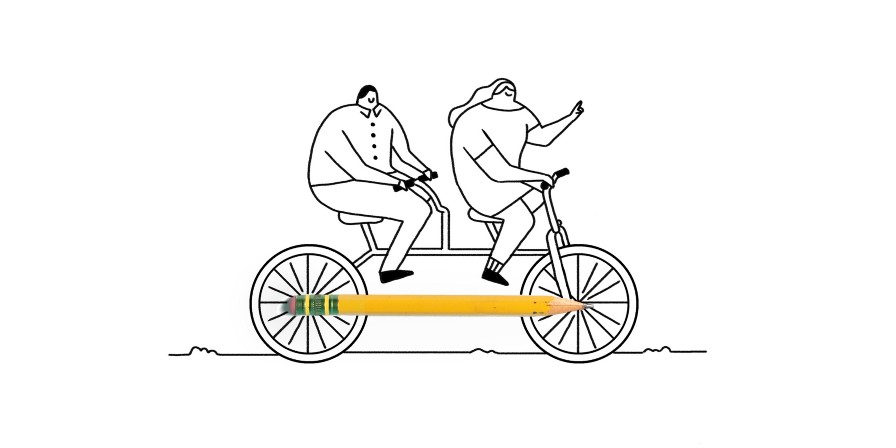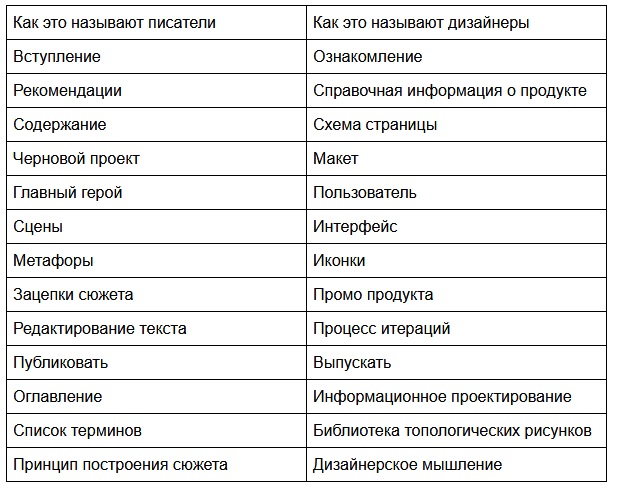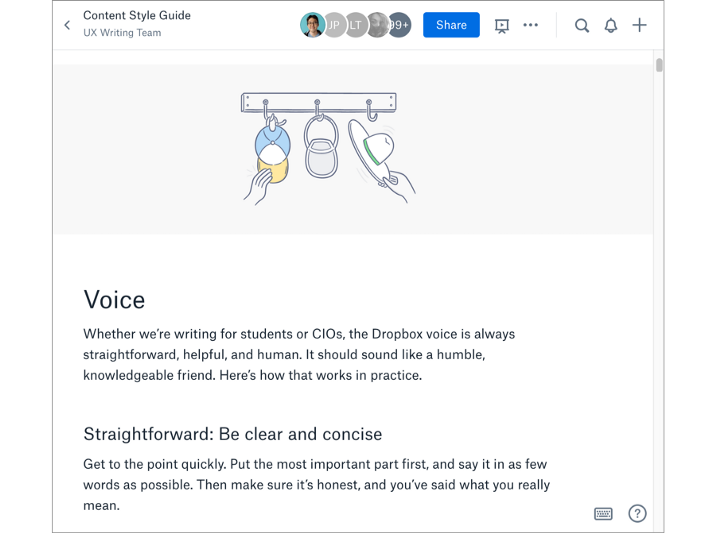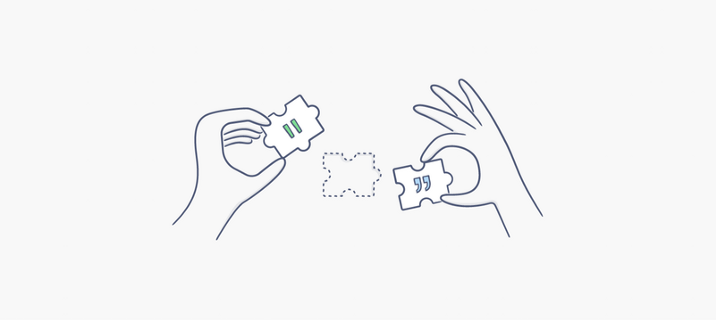How to strengthen the design team with the help of an intelligent writer
- Transfer
Six reasons why a writer (writer) is a turbocharger for design (from a Dropbox UX specialist).

Recently, there has been a lot of hype around texts in design. You can call it texts perceived by users, a product description or content design, one thing is clear - the words play an important role in your design.
In his speech “Design in Tech 2017”, John Maeda said: “Words are really important because graphics sometimes make no sense.” Fast Co Design continued this idea in an article entitled “Forget about code: Manner writing is the designer's main skill . ”
It sounds simple, right? To be a great designer, you need to know how to write. It's okay. You write all the time. Email, specs, tweets are nothing supernatural.
I am a writer and a former English teacher and I find it difficult to write. It’s hard to learn to write and hard to teach. That's why there are over 500,000 text writing books on Amazon!
The mechanics of writing are hard enough to comprehend, but did you know what is really difficult? Concepts such as choice of words, tone and rhythm. It takes an eternity to master these skills.
So what do the design team do?
In case you haven’t noticed, more and more design teams are starting to hire writers - writers who think like designers.
Big and small companies understand the importance of good publishing material, and they hire writers to make words. Adobe, Spotify, Slack, HBO, GoPro, Intercom - over the past couple of years, all these companies have hired their first writers. Product writers are everywhere.
I know that not everyone can afford to hire a writer, but think about it. The next time you struggle with words, just think about it. What if you take the writer to your team? The writer may be the missing piece of the puzzle that you need so much.
Below are a few reasons why I believe that every design team should hire a writer.
Designing something is very similar to writing a story - an interactive story. And to tell a compelling story, you need to have a writer in stock.
When it comes to product design, the writer becomes the storyteller, guiding the protagonist (your user) from scene to scene on screen.
Regardless of whether you call yourself a writer or a designer, you can notice many analogies between the two disciplines. Just look at all the parallels:

A few wrong words can cause big design problems. It would be great if you had a writer who could help solve design problems with words, right?
While designers tend to focus on one area of a product, writers in charge of a product tend to focus on different areas of a product. And this is good, because it allows writers to see the connections and discrepancies in the overall picture.
Writers are the link between different areas of production. We help promote product connectivity, especially when it comes to language.
In the end, it hurts the hearing pretty much if in one place we say “Oh hell” and in another “A terminal error is detected”.
How to make sure that we use a consistent language everywhere? At Dropbox, one of the ways we use it is to use the style guide. It contains details about voice, tone, terminology, punctuation, capitalization, accessibility, and more.

Our style guide helps us use consistent language in Dropbox.
When describing the interface, it is important to know when to shut up and get out of the way. Most of the time you do not want to force users to read anything. People are trying to get something to work and the last thing they want to do is read your interface.
But sometimes you want your words to be noticed. Then you want to speak out and want to be heard clearly and clearly. Maybe the user has done something amazing and you want the whole world to know about it.
Well, it turned out that writers are good at setting the tone. Writers know when to raise it, and when to lower it. We know when to be energetic or patient, decisive or pretentious.
And I guarantee you that the writer will closely monitor every taunt, comment and statement in your message, because we take care to convey the right tone at the right time.

Writers help set the right tone.
Good writers care about the details. Whether it's a misspelled word or a comma, good writers care about the quality of the material.
But does language quality really matter? Is the fact that there is a flake in your product is a big problem? Does it really matter if you have “log in” on one page and “register” on the other?
I think the quality of the language certainly matters. It all comes down to trust. As users begin to notice typos and inconsistencies, they begin to lose credibility in your company. If your company cannot allocate time to write correctly, why should they trust you with their time and money?
Writers monitor your language so that you don’t lose user confidence.

Writers care about the details.
Presumably, Einstein once said: "If you cannot explain something in simple words, you yourself do not understand this." This is fundamentally true when it comes to writing a product.
As product writers, we are often asked to explain complex concepts in simple words. And sometimes in the process of writing, we understand that explaining the update is easy and understandable is simply impossible. This usually means that the design is not intuitive.
Then we go to the designers and try to come up with a solution to this problem together. Writers are not afraid to point out to the designer that their design is meaningless because the confusing design leads to confusing writing.
In other words, writers make designers get better, and good designs lead to even better texts. Real magic happens when everyone shares ideas and works together to achieve something perfect.
And don't forget: writers are your main fans. We are creative, as are you. We love art, movement and new discoveries. We love design too.

Writers like to collaborate with designers.
Do you know the secret to writing good stuff? Good material is the result of many time-tested techniques that writers have been using for years. If you look closely, you will notice these tricks in almost any good article.
To demonstrate this to you, I tried to use a number of these techniques throughout the article. Here are some tricks I used:
How many tricks did you find reading the post?
In writing a product, these tricks come in handy, especially when you draw up a promo, landing page, feature sheet, letter, or introduction to the new system. These techniques help your article material to be more compelling.
Anyone can learn to write compelling stories, but it takes years to master. Writers have been honing their skills for years, so why not take advantage of their experience?
I hope after reading this article you will see what value writers can bring to your design team. When you think about expanding your team, consider hiring a writer. Your users will love you more, thanks to this.
Each product has an amazing story worth telling. Wouldn't it be nice to have a writer to help tell your story?
If you're ready to start looking for a writer, here are a few related articles that can help you with this:
EDISON Software is professionally engaged in the development of applications and sites in PHP for large customers, as well as the development of cloud services and mobile applications in Java, and we try to make the appearance of the products as user-friendly as possible, and the "technical duty" of UX designers is reduced . Here is a selection of useful Usability articles:

Recently, there has been a lot of hype around texts in design. You can call it texts perceived by users, a product description or content design, one thing is clear - the words play an important role in your design.
In his speech “Design in Tech 2017”, John Maeda said: “Words are really important because graphics sometimes make no sense.” Fast Co Design continued this idea in an article entitled “Forget about code: Manner writing is the designer's main skill . ”
It sounds simple, right? To be a great designer, you need to know how to write. It's okay. You write all the time. Email, specs, tweets are nothing supernatural.
I am a writer and a former English teacher and I find it difficult to write. It’s hard to learn to write and hard to teach. That's why there are over 500,000 text writing books on Amazon!
The mechanics of writing are hard enough to comprehend, but did you know what is really difficult? Concepts such as choice of words, tone and rhythm. It takes an eternity to master these skills.
So what do the design team do?
Have you considered hiring a writer?
In case you haven’t noticed, more and more design teams are starting to hire writers - writers who think like designers.
Big and small companies understand the importance of good publishing material, and they hire writers to make words. Adobe, Spotify, Slack, HBO, GoPro, Intercom - over the past couple of years, all these companies have hired their first writers. Product writers are everywhere.
I know that not everyone can afford to hire a writer, but think about it. The next time you struggle with words, just think about it. What if you take the writer to your team? The writer may be the missing piece of the puzzle that you need so much.
Below are a few reasons why I believe that every design team should hire a writer.
1. Writers are designers
Designing something is very similar to writing a story - an interactive story. And to tell a compelling story, you need to have a writer in stock.
When it comes to product design, the writer becomes the storyteller, guiding the protagonist (your user) from scene to scene on screen.
Regardless of whether you call yourself a writer or a designer, you can notice many analogies between the two disciplines. Just look at all the parallels:

A few wrong words can cause big design problems. It would be great if you had a writer who could help solve design problems with words, right?
2. Writers connect the dots
While designers tend to focus on one area of a product, writers in charge of a product tend to focus on different areas of a product. And this is good, because it allows writers to see the connections and discrepancies in the overall picture.
Writers are the link between different areas of production. We help promote product connectivity, especially when it comes to language.
In the end, it hurts the hearing pretty much if in one place we say “Oh hell” and in another “A terminal error is detected”.
How to make sure that we use a consistent language everywhere? At Dropbox, one of the ways we use it is to use the style guide. It contains details about voice, tone, terminology, punctuation, capitalization, accessibility, and more.
- Can we use the word “content”? See the style guide.
- Are we talking drag & drop (drag and drop function) or just drop? See the style guide.
- Is it normal to use emoji in correspondence? See the style guide.
- Are we capitalizing the word after the colon? See the style guide.
- How do we write modal verbs? See the style guide.
- We treat our style guide as a living document and update it at least once a month. And we store it in Dropbox Paper, so it’s easy to find, it is easily accessible and easily updated.

Our style guide helps us use consistent language in Dropbox.
3. Writers know when to speak and when to shut up
When describing the interface, it is important to know when to shut up and get out of the way. Most of the time you do not want to force users to read anything. People are trying to get something to work and the last thing they want to do is read your interface.
But sometimes you want your words to be noticed. Then you want to speak out and want to be heard clearly and clearly. Maybe the user has done something amazing and you want the whole world to know about it.
Well, it turned out that writers are good at setting the tone. Writers know when to raise it, and when to lower it. We know when to be energetic or patient, decisive or pretentious.
And I guarantee you that the writer will closely monitor every taunt, comment and statement in your message, because we take care to convey the right tone at the right time.

Writers help set the right tone.
4. Writers Watch the Language
Good writers care about the details. Whether it's a misspelled word or a comma, good writers care about the quality of the material.
But does language quality really matter? Is the fact that there is a flake in your product is a big problem? Does it really matter if you have “log in” on one page and “register” on the other?
I think the quality of the language certainly matters. It all comes down to trust. As users begin to notice typos and inconsistencies, they begin to lose credibility in your company. If your company cannot allocate time to write correctly, why should they trust you with their time and money?
Writers monitor your language so that you don’t lose user confidence.

Writers care about the details.
5. Writers motivate you to become better designers.
Presumably, Einstein once said: "If you cannot explain something in simple words, you yourself do not understand this." This is fundamentally true when it comes to writing a product.
As product writers, we are often asked to explain complex concepts in simple words. And sometimes in the process of writing, we understand that explaining the update is easy and understandable is simply impossible. This usually means that the design is not intuitive.
Then we go to the designers and try to come up with a solution to this problem together. Writers are not afraid to point out to the designer that their design is meaningless because the confusing design leads to confusing writing.
In other words, writers make designers get better, and good designs lead to even better texts. Real magic happens when everyone shares ideas and works together to achieve something perfect.
And don't forget: writers are your main fans. We are creative, as are you. We love art, movement and new discoveries. We love design too.

Writers like to collaborate with designers.
6. Writers have their own approach to words
Do you know the secret to writing good stuff? Good material is the result of many time-tested techniques that writers have been using for years. If you look closely, you will notice these tricks in almost any good article.
To demonstrate this to you, I tried to use a number of these techniques throughout the article. Here are some tricks I used:
- Alliteration: Using words that start with the same sound to make a sentence expressive
- Rhyme: Using words that end in the same sound to make the sentence memorable
- Amplification: The repetition of certain words and phrases to unnecessarily focus on certain words
- Concurrency: Repetition of the same grammatical structure to make words more memorable
- Antithesis: Opposition of different concepts in order to express their thoughts more clearly
- Intonation: Creating a tempo based on syllables and using emphasis on every word
- Rule of Three: Mention various things in groups of three to set the shape, beat, or rhythm
- Metaphor: A reference to one concept through the mention of another, usually in a smart way.
- Value of Proposal: Emphasizing benefits for the user to make him act
- Rhetorical question: Using a question instead of a statement in order to convey the main point
- Question-answer: Ask a question in order to spread interest and answer it yourself. Also known as hypophora
How many tricks did you find reading the post?
In writing a product, these tricks come in handy, especially when you draw up a promo, landing page, feature sheet, letter, or introduction to the new system. These techniques help your article material to be more compelling.
Anyone can learn to write compelling stories, but it takes years to master. Writers have been honing their skills for years, so why not take advantage of their experience?
Okay, let's hire a writer
I hope after reading this article you will see what value writers can bring to your design team. When you think about expanding your team, consider hiring a writer. Your users will love you more, thanks to this.
Each product has an amazing story worth telling. Wouldn't it be nice to have a writer to help tell your story?
If you're ready to start looking for a writer, here are a few related articles that can help you with this:
- Hiring your first UX writer by Sara Culver
- How to find product content strategists by Alaine Mackenzie
EDISON Software is professionally engaged in the development of applications and sites in PHP for large customers, as well as the development of cloud services and mobile applications in Java, and we try to make the appearance of the products as user-friendly as possible, and the "technical duty" of UX designers is reduced . Here is a selection of useful Usability articles:
